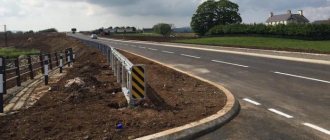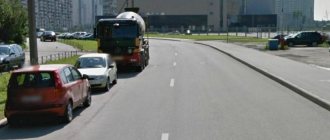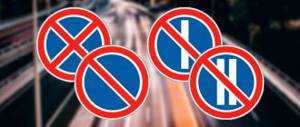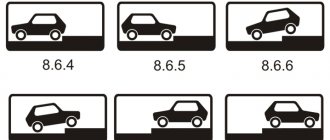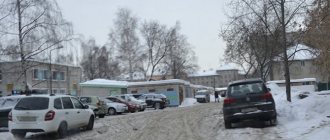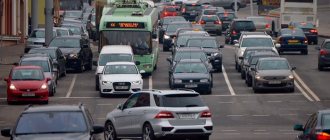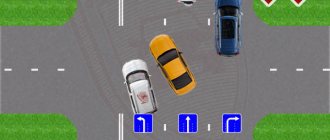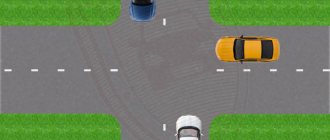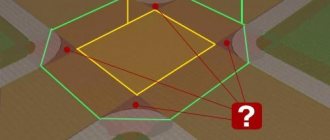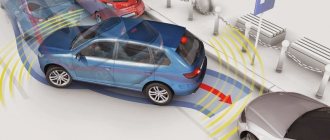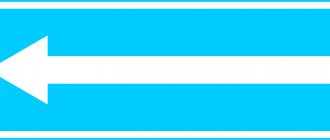Actions in a controversial situation
Correct designation of places where cars are allowed to park and stop at a T-shaped intersection or, conversely, where they are taboo, occurs with the help of special signs that can be installed separately or together with explanatory signs and inscriptions indicating the zone and time of operation.
For similar purposes, yellow road markings are also required in the form of continuous and interrupted stripes, which are applied on the right edge of the road surface or curbs. In addition, it is important to remember that the main requirements limit a certain list of locations where stopping in any form is prohibited, regardless of the presence or absence of appropriate markings (clause 12.4).
Although sometimes a certain conflict between a road sign and other markings on the highway still arises: when they are not located in accordance with GOST, i.e. not on the same line - there is a contradiction between them. But in practice, it’s quite easy to figure it out: you just have to refer to the traffic rules, which state that “if the meanings of road signs (even temporary ones) and horizontal marking lines contradict each other or are not distinguishable enough, drivers must be guided by the road signs.” It turns out that the “Stop line” sign has priority over the markings and you need to brake in front of it.
Drivers must clearly understand the stopping place at a T-shaped intersection, since the fine for crossing the stop line is quite large and the traffic police officer has the right to impose it if a violation is recorded. But in the event of a conflict situation, you just need to show the traffic police officer a link to the relevant legislative act and defend your case.
Where is it allowed and where is it forbidden to park?
You can stop after a pedestrian crossing if there is no sign prohibiting stopping or parking.
Wrong parking at the intersection of the street. Orangery and Degtyarevskaya. Cars parked in the middle interfere with traffic.
Rules for his passage. Where is stopping and parking prohibited according to traffic regulations? Fundamental rules for stopping at an intersection. Special cases: controlled and unregulated intersections, the presence of a stop line and a STOP sign. Stopping rules for T-junctions.
Stopping and parking are allowed 15 meters from the markings or sign
- Public transport stops and entrance and exit areas within 15 m from the beginning and end of the stop. Route public transport stops are indicated by special information signs or yellow broken road markings. If there are markings, the prohibited zone begins and ends at its boundaries. Taxi ranks, marked with the appropriate sign (see sign 5.18), also belong to those areas where it is prohibited for other types of transport to park.
Driving through intersections often causes difficulties for novice drivers. As for stopping at an intersection, it causes even greater problems. Is this even allowed? Are there exceptions to the rules? What consequences occur due to their violation? We will answer these and other questions related to the topic in the article.
Rice. 120 and in the cases established by paragraph 12.2 of the Rules - on the sidewalk
Intersection boundary. determine the entry point to the intersection
As for the “left” stop on a one-way road, it is logical and should not cause confusion (Fig. 121b). And in Fig. 121c shows situations when stopping and parking on the left side of the road is prohibited.
12.2. It is allowed to park a vehicle in one row parallel to the edge of the roadway, with the exception of those places where the configuration (local widening of the roadway) allows for a different arrangement of vehicles.
Two-wheeled vehicles without a side trailer may be parked in two rows.
Parking on the edge of the sidewalk bordering the roadway is permitted only for cars, motorcycles, mopeds and bicycles in places marked with sign 6.4 with one of the signs 8.6.2, 8.6.3, 8.6.6—8.6.9. Three important points need to be highlighted. 1. The vehicle may be parked at an angle to the roadway only in those places where this is determined by signs, markings or road configuration (in so-called pockets).
2. Only passenger cars (as well as motorcycles, mopeds and bicycles) can use the sidewalk for stopping and parking, and only if the parking area is indicated by the signs specified in clause 12.2, which determine the specific method of location on the sidewalk. In other places, driving onto the sidewalk to stop and park is completely or partially prohibited!
3. Trucks, buses and the like, regardless of the permitted maximum weight, passenger capacity and size, cannot be parked either partially or completely on the sidewalk! 12.3. Parking for the purpose of long-term rest, overnight stay, etc. outside a populated area is permitted only in areas provided for this purpose or off the road. 12.4. Stopping is prohibited: - on tram tracks, as well as in the immediate vicinity of them, if this will interfere with the movement of trams; — at railway crossings, in tunnels, as well as on overpasses, bridges, overpasses (if there are less than three lanes for traffic in a given direction) and under them; - in places,
Is stopping at a T-junction allowed?
T-shaped intersection - driving rules with analysis of situations. Stop or parking
1 Violation of the rules for stopping or parking a vehicle, except for the cases provided for in part 1 of article 12.10 of the Administrative Code and parts 2 - 6 of this article Warning or fine 500 rubles.
2500 rub. 12.19 h. 2 Violation of the rules for stopping or parking a vehicle in places designated for stopping or parking a vehicle for disabled people from 3,000 to 5,000 rubles.
12.19 Part 3 Stopping or parking a vehicle at a pedestrian crossing and closer than 5 meters in front of it, with the exception of a forced stop and the case provided for in Part 6 of this article, or violation of the rules for stopping or parking a vehicle on the sidewalk, except for the case provided for in Part 6 of this article 1000 rub.
3000 rub. 12.19 part 3.1 Stopping or parking a vehicle at the stopping places of route vehicles or closer than 15 meters from the stopping places of route vehicles, with the exception of stopping for boarding or disembarking passengers, a forced stop and cases provided for in parts 4 and 6 of this article 1000 rubles. 3000 rub. 12.19 Part 3.2 Stopping or parking a vehicle on tram tracks or stopping or parking a vehicle further than the first row from the edge of the roadway, with the exception of a forced stop and the cases provided for in parts 4 and 6 of this article RUB 1,500. 3000 rub. 12.19 part 4 Violation of the rules for stopping or parking a vehicle on the roadway, resulting in the creation of obstacles to the movement of other vehicles, as well as stopping or parking a vehicle in a tunnel, except for the case provided for in part 6 of this article 2000 rubles.
3000 rub. detention of a vehicle 12.19 hours 5 Violation provided for in part 1 of this article, committed in Moscow or St. Petersburg 2500 rubles. 12.19 p. 6 Violations provided for in parts 3 - 4 of this article, committed in the federal city of Moscow or St. Petersburg 3,000 rubles.
Alas, Moscow cannot boast of such parking procedures. Photo by masterok.livejournal.com Remember a simple axiom - only a tank driver does not have to know how to park his vehicle.
For everyone else, the traffic rules spell out parking rules.
Fundamental rules for stopping at an intersection
Parking lot: A place where a vehicle is placed in a non-operational state and left for a short period of time. The car is not guarded during long-term parking.
When a sign is combined with plates 8.6.4-8.6.9 and road marking lines, parking a vehicle is permitted at an angle to the edge of the roadway if the space allows such an arrangement.
In principle, the traffic rules do not distinguish them into a separate category, so there are no special rules for them.
The driver of car “2” is wrong twice. First, he violated the requirement of the rule just discussed. And secondly, his car is closer than 5 m in front of the pedestrian crossing. Thus, it prevents pedestrians and drivers of cars approaching from behind from seeing each other.
It is much more difficult to adhere to them in cities - in areas with heavy traffic, where the abundance of vehicles sometimes forces drivers to deliberately break the rules and park their car close to the zebra crossing or right on it.
At this point, you are once again called upon to behave rationally on the road. When you stop your car in one place or another, you should think about other road users: “Will I disturb anyone by stopping?” That's a good question. If every driver asks himself this question more often, life on the road will become much calmer.
Didn't find any prohibitory markings or signs? Feel free to park on the side of the road. The main thing is not second row. But if you need to stop on the highway, then on the side of the road in this case it can be extremely unsafe, especially at night. Therefore, during long journeys, choose places for parking that are marked with “Rest Place” or “Camping” signs.
Let us now examine in detail the case of stopping at an intersection with a marked stop line. In this case, the driver must stop strictly in front of her. It can be applied to the road surface in two ways:
- Using markup.
- Via sign 6.16 called “STOP”.
If there are no markings on the road surface, but there is a “STOP” sign near the roadway, then the driver must stop before reaching it.
This may be the case. There are markings on the highway, but at the same time there is a STOP sign by the road. Where should the driver stop at the intersection in this case? Driving instructors believe that he should stop the car here directly at the sign. This is primarily due to the rule of priority of road signs over markings.
Automotive portal. Answers on questions
In resort towns, tow trucks are actively working, but we constantly have traffic jams because of those who are too lazy to walk the extra 50 meters from the parking lot.
And you need to update your knowledge about traffic rules more often, otherwise you won’t get rid of extra fines. Eduard I was once standing in a traffic jam and I saw some motorists driving around the lane on the side of the road. Outrageous. What could they face for this?
Of course, they are unlikely to deprive of their rights; I think they will issue a fine; if so, in what amount?
Galina I read the article and decided that the traffic rules need to be reviewed again. Over time, information is forgotten; now I only navigate ordinary road situations. Pavel was in St. Petersburg, there was practically nowhere to stop near the museums, we had to leave the car far along the road, so he noticed that traffic cops with a tape measure were measuring the distance from cars to intersections and pedestrian crossings.
I drove half a meter onto a tow truck!
Nikolai Once proved his case to the inspector. I stopped on the bridge, there was a beautiful view of the city, I decided to take a photo.
A traffic police car arrived and the inspector told me that stopping in this place was prohibited. There were three lanes in one direction, especially since I often saw cars stopping here.
In the distance there was a sign that, according to the inspector, prohibited stopping here. I had to walk around to make sure that the visible sign did not belong to this area. In the end, we left without a fine, but the inspector promised to catch me in another place.
Ten years have passed since then, I have not seen him again. Maria Particularly annoying are the parking signs based on time and even and odd numbers.
I mixed up the date and was looking for a car. I thought it was stolen, but it was the tow truck that took it away Ivanovich In the good old days, when there were significantly fewer cars on the roads, even then violation of stopping and parking rules was not uncommon.
The most common violations were: stopping outside the city on the left side of the road, unloading passengers onto the roadway.
Many drivers did not understand the difference between the operation of “no stopping” and “no parking” signs. Drivers often stopped in prohibited places, making it difficult for other cars to move.
Rules for driving at controlled intersections
If there are traffic lights at the intersection, driving through it will not be difficult. If a traffic controller works on it, it is also considered regulated.
But even when driving through such an intersection there are features that have to be taken into account:
- Moving cars determine the priority of movement, guided by the “Interference on the right” rule.
- If there are tram tracks at the intersection, the tram passes first.
- If the red traffic light and the permission signal at the additional section are on at the same time, you can make a turn in the indicated direction, but first you will have to let other cars go through the green light.
- It is forbidden to use “reverse”.
Rules for driving at controlled intersections
The rules for driving through intersections with traffic lights are regulated by the traffic lights (which are the main ones) and the signals of additional sections.
Vehicles moving on the main green traffic light must determine priority among themselves in accordance with the “interference on the right” rule. Let's say you're turning left at a crossroads, and an oncoming car is moving straight ahead. When the green light turns on, you must enter the intersection, starting the maneuver, and let the oncoming car pass, and only then complete the turn.
If the red or yellow signals and the additional section of the traffic light are on at the same time, first let through all vehicles for which the main green signal is on, and only then move in the direction indicated by the signal of the additional section.
Video lesson: driving through intersections according to the rules.
There are different types of intersections and each of them has its own rules. In addition to ordinary ones, there are often T-intersections, when one part of the road runs perpendicular to another. To move safely around the city, every driver must know the rules for driving through T-intersections.
Is stopping allowed?
If there is a traffic light control at a T-shaped intersection, then, according to statistics, difficulties when driving in that place are unlikely. Especially if the roadway is organized in the form of stripes and is indicated by markings under paragraph 1.18, as well as similar signs under paragraph 5.15.2 and traffic lights with an additional section. Before starting the desired maneuver in the direction of the future passage, any driver is obliged to change lanes in advance to the required lane.
Typical movement in the direction of the arrow of the additional section of the traffic light is only possible if the corresponding indicator is activated. When driving through a green arrow, activated in parallel with the main red light, there is a need for increased vigilance. In this case, you must definitely give way to other vehicles that are going in a different direction - this is exactly what is prescribed in modern traffic regulations.
The classic regulations do not form T-shaped intersections into a separate category with new requirements. Therefore, the basic conditions within the specified locations are almost similar to the generally accepted traffic rules at all intersections.
Exceptions to the rules
Almost any rule has its own clarifications and reservations, so this case also has similar additions. First of all, you should read clause 12.4, which provides for an exception where T-shaped intersections are mentioned.
According to that text, there is another prohibition regarding stopping a car closer than 5 m from the edge of the intersecting roadway, with the exception of the side opposite the side passage of 3-way intersections with a solid marking line or dividing strip. That is, the possibility of parking on a T-shaped fork directly depends on what markings are on the highway:
- solid or double – stopping is permissible;
- intermittent or non-existent – parking is excluded.
At the same time, at the intersection, a rule must be observed that requires stopping no closer than 3 meters from the marking itself . Separately, you can also remember about parking on the left side of the road, which is allowed only when the roadway is in a populated area on a highway with a single lane for both directions or in one-way traffic.
When such a designation is absent at the mentioned location or smoothly turns into a broken line, the rules prohibit stopping a vehicle in the T-shaped intersection area, since the car will create an obstacle to cars leaving the adjacent road and making a U-turn. And if the mentioned paths are also narrow, then such a maneuver risks blocking through traffic and causing traffic jams.
Free legal consultation: For any questions
Example: I took out loans from a microfinance organization to renovate an apartment and treat an illness.
True, drivers of trucks whose permissible maximum weight exceeds 3.5 tons must remember that in these conditions they are only allowed to stop and exclusively for loading and unloading the vehicle.
What should I do? Moscow St. Petersburg By clicking the SEND button, you accept the terms and conditions Send Send
Moscow Government
Ministry of Justice of the Russian Federation
Rospotrebnadzor Latest questions Full comprehensive service From the moment you contact us until the issue is completely resolved, we are ready to accompany our clients, providing them with the necessary services and advice.
I realized late that these were unaffordable loans for me. They call and threaten with various methods of influence.
Free detailed analysis of the situation Our specialists will study your situation in detail, review all available documents, and draw up a clear picture of the problem.
Working for results We are interested in the success of your business! Your victories are our victories. We are exclusively results-oriented.
Drawing up documents If necessary, the lawyers of our company will take upon themselves the preparation of all the necessary documents for a positive resolution of the case. Free study of options Only after a detailed analysis of the available documents and immersion in the current situation will we be able to work out solutions and the feasibility of their use. Submitting documents We take care of everything.
Compilation. Collection of the necessary package of documents. Submission to the authorities. Tracking. Control of every movement of the case.
There is always a possibility that the client does not need to go to court or draw up a claim and other documents, since there is no prospect of winning and the client will waste time and money, or worse, worsen his situation. This is why our company’s lawyers first do a free analysis of the situation, study the available documents, and only after that offer solutions, if any.
Why do they trust us? Quality of service For more than 10 years, our company has been providing free legal advice in various areas of civil law. Speed Professionals in their field will advise you within 5 minutes. And you will know everything about solving your situation.
Knowledge Each client's case is transferred to the appropriate legal department, where it is analyzed by at least 3 specialists, including a senior lawyer.
Confidentiality In accordance with the Federal Law of the Russian Federation of July 27, 2006 N 152 “On Personal Data”, we guarantee complete confidentiality of all consultations. Savings Thanks to our extensive experience in the field of civil law, we can confidently say what to do in various situations. Minimum actions for maximum results.
Ease When contacting us, clients forget about their problem. Entrust your care to us, professionals in our field.
Get a free consultation right now! Moscow St. Petersburg By clicking the SEND button, you accept the terms Send Send Our lawyers and attorneys will help you “Every problem can be solved through the means of the law. There's nothing complicated about it. The only thing that is difficult is knowing these laws.” Astafiev Valery Semenovich leading specialist of the Legal Bureau
Proskuryakov Mikhail Lawyer
Karpova Elena Lawyer
PilchevskyYuri Advocate
SazonovaNatalia Lawyer
Parking at a T-junction, 4 lanes.
Stopping at a T-junction
However, if the bridge is wide and has more than two passing lanes, stopping is allowed, since you will not interfere with the movement of other vehicles. In tunnels and places under overpasses and bridges. However, if there is an equipped area and a parking sign, then parking there is allowed.
On narrow roads, where the distance between a solid marking line (except for the edge of the roadway), a dividing strip or the opposite edge of the roadway and a stopped vehicle is less than 3 m, since this makes it difficult to bypass vehicles standing there and will require the driver to cross the dividing line, which prohibited by the rules. At a distance of less than 5 m from the edge of pedestrian crossings and their marked area, designated by wide longitudinal stripes or intermittent narrow transverse stripes, which can cross the road either perpendicularly or at a slight angle. Before pedestrian crossings, after them, you can at least immediately place them if there are no other prohibitions.
The logic of this rule is that a vehicle standing in front of a crossing blocks the view of other drivers and they may not notice the pedestrian, and the pedestrian may not notice them, which increases the chance of an accident.
At intersections, at a distance of up to 5m.
in all directions from the intersection boundaries.
At public transport stops, 15m from the end and beginning of the stop. As a rule, stops are marked with special signs and yellow markings.
The taxi rank is also marked with sign 5.18, and other vehicles are also prohibited from parking there. On public transport lanes and bicycle lanes.
These stripes are indicated by special signs or markings in the form of the letter A.
On any sections of the roadway with road visibility in any direction of less than 100m. This limited visibility may be due to curves and slopes of the road. On sections of the roadway where a parked car will block the visibility of signs or traffic lights to other road users.
Basic provisions of the intersection
If you refer to the traffic rules, then a T-shaped intersection is considered as a merger, intersection or branch of roads that are at the same level (clause 1.2). So, when studying the definition of stopping at a specified location, you need to understand that intersections of paths at different levels (for example, under bridges) will in fact no longer be considered an intersection.
From the point of view of traffic safety, the mentioned place can be equated to a zone of concentration of conflict situations that are only permissible on the roads. Because this is where the most current directions of vehicle movement are involved.
A specific subtype - the T-shaped version - is interpreted by the rules as the process of merging two routes, where one road “enters” perpendicularly (but this is not always) into the other. Often the angle of entry is as close as possible to 90°. But in the case of a merger, where the intersection is sharper or dumber than the given standards, a different kind of intersection is obtained, which is rather identical to the letter “Y”. Although the most important element still remains not the angle of intersection of roads, but the very fact of their intersection.
Sequence of actions when passing an intersection
Group of signs “main road” 2.1-2.3.7
The process of crossing the intersection consists of three successive stages. Each of them is carried out separately, but in a certain order.
The procedure for driving through an intersection begins even before the driver enters it, namely with determining and understanding its type. Each type of intersection has its own rules of passage. An error at this stage will entail the application of false rules and the development of an incorrect driving sequence, which can in turn cause a collision with another vehicle.
All intersections are divided into regulated and unregulated. Uncontrolled intersections can be of equal or unequal significance. Among the unequal ones, intersections with a turn on the main road and without a turn are distinguished. The type of intersection is determined based on a set of specific features.
Driving conditions through one or another intersection can vary greatly. The type and equipment of an intersection is determined by the number of vehicles passing through it per day or per hour, that is, the traffic intensity. Lightly trafficked roads, on which vehicles rarely meet each other, usually have uncontrolled equivalent intersections. This is the simplest type. Uneven intersections occur on roads with moderate traffic volumes. One road passing through them is the main one, and the other is a secondary one. At unequal intersections, priority signs are installed to help drivers navigate which road is which. The risk of collision at such intersections is less than at unregulated equivalent ones.
A controlled intersection is in demand at high traffic volumes. It is equipped with traffic lights. Such traffic organization can ensure fairly safe interaction between large traffic and pedestrian flows, intersecting in one place and branching in different directions.
At the second stage of the process of overcoming the intersection, you need to enter it correctly
If there are several vehicles, it is important to determine who needs to give way and who, on the contrary, will have to let your car pass. After waiting your turn, you can enter the intersection.
The third stage is leaving the intersection. The order of movement is determined by the direction of further travel (straight, turn, right or left).
At any intersection, a situation may arise in which the driver who entered it first is the last to leave and vice versa.
Chapter 13 of the Traffic Regulations describes in detail all the actions associated with driving through various intersections.
Rules for driving through unregulated intersections
Let's consider the basic rules of travel and possible situations for unregulated intersections of all types.
Equivalent intersection and driving rules
The rules for driving through intersections of equivalent roads are governed by the “interference on the right” rule - the driver must always give way to vehicles approaching from the right side of the roadway. This also applies to those cars that will become an “obstacle on the right” when the driver makes a maneuver.
Consider the situation: you are crossing an equivalent cross-shaped intersection straight ahead, without turning. There are two cars on the transverse road - one on the left (let's call it A), one on the right (it will be designated B), both plan to continue moving straight. According to the “interference on the right” rule, you give way to car B since it is on your right. In turn, vehicle A must give way to you in the same way.
If there is no stop line
Now let's look at a more complex case - stopping at an intersection without a stop line. You need to first separate the two options:
- Pedestrians follow the intersection.
- There are no pedestrians at the intersection.
It should be taken into account that if you place a car close to a traffic light in the right lane, from which other vehicles are making a turn, this can create a traffic situation.
The car may also be towed. Shoulder is a part of the road that is at the same level and is not separated by curbs or grass. It stands out with special markings. Parking is allowed there.
If we look at the traffic rules, pedestrians are only allowed to cross the highway at the appropriate pedestrian crossings (overground and underground). If they are absent, at intersections along the lines of curbs and sidewalks.
So, stopping is prohibited at the intersection of two or more carriageway lanes. And also in places that are closer to intersections by less than 5 m. An exception to this rule is the sides opposite the side passages of three-way intersections, which have either a dividing strip or a solid marking line.
Let's consider where you need to stop when there is a prohibitory signal from a traffic light or a traffic controller.
Fines for traffic violations
Stopping incorrectly at a T-junction may result in penalties. To understand the financial issue, you need to refer to the Code of Administrative Offenses - details about financial liability and other penalties for improper parking of vehicles are stated in Parts 1 and 2 of Art. 12.19. In particular, the following list of consequences is provided:
- Ignoring the requirements prescribed by road markings or signs – 500 rubles.
- Failure to comply with traffic regulations to stop in front of the stop line when there is a prohibitory signal or gesture - 800 rubles.
- Crossing a stop line or a “Stop” road sign at a T-shaped intersection – 800 rubles.
- Stopping or parking at railway crossings – 1 thousand rubles. and deprivation of the certificate for a period of 3-6 months.
- Making a stop at a pedestrian crossing at an intersection – 1-3 thousand rubles. (depending on the region of the Russian Federation).
- Parking vehicles on the roadway beyond the first lane - 1-1.5 thousand rubles.
- Stopping on the roadway and creating obstacles for the movement of other cars – 2-3 thousand rubles.
- Parking in areas where similar prohibition signs apply – 1.5-3 thousand rubles.
- Violations of other kinds – 500-2 thousand rubles.
It turns out that the stopping place at a T-shaped intersection is not always permitted by traffic regulations. In practice, fines for such offenses vary in terms of amount. Sometimes the final amount of the sanction reaches 5 thousand rubles.
Sometimes, for violating parking requirements on a specific section of the highway, the car may be towed to a penalty parking lot. Although in most cases, for an erroneous stop, the driver faces only a minimum administrative fine of 500 rubles or only a verbal warning.
| Did not find an answer to your question? Call a lawyer! Moscow: +7 (499) 110-89-42 St. Petersburg: +7 (812) 385-56-34 Russia: +7 (499) 755-96-84 |
Motorists should definitely remember the main rules for stopping at intersections (all, not just T-shaped ones). To understand when they are necessary or prohibited, it is worth studying the road signs, markings, signals and gestures that regulate such moments on the highway. Then road users will not have problems, and the risk of accidents due to unsuccessful parking will be reduced to zero.
